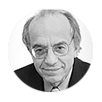An Interview with the Fed’s James Bullard


On last week’s “Behind the Markets” podcast, Jeremy Schwartz and Professor Jeremy Siegel interviewed James Bullard, president and CEO of the Federal Reserve (Fed) Bank of St. Louis. Despite the recent spate of better-than-expected U.S. economic data, Bullard did not back down from advocating a 50-basis point (bps) cut in the Federal Funds rate at the Fed’s last policy meeting, dissenting from the majority decision to lower just 25 basis points. He maintained that the increased uncertainty about U.S. trade policy has had a significant effect on foreign economies and impacted business decisions in the U.S. In fact, during our interview, the Dow Jones Industrial Average fell 200 points in response to news that Chinese negotiators had withdrawn from recent trade negotiations.
Further supporting his dissent, Bullard said, “We just have to face up to the idea it is an extremely low interest-rate environment globally and U.S. yields can’t get too out of line from those global yields, even though our economy is somewhat better than some other places in the world.” I concurred, noting that although U.S. growth rates are about 1% above those in Europe, our interest rates, relative to inflation, are 2% to 3% higher. Bullard agreed that the “neutral Fed funds rate,” the funds rate that is neither expansionary nor contractionary, might be below the new 1.75% to 2.00% range set last Wednesday.
Bullard agreed that the term structure was the best single indicator of a recession in the post-war period. He reiterated that he had been “fooled” twice during his tenure on the Federal Open Market Committee (FOMC) by presentations from Fed research staff saying that inversion of the term structure did not presage recession. He vowed not to be fooled again.
When I pointed out that the “dot plot” indicated that ten of the 17 FOMC members did not want any further cuts, he said those indications were made before the meeting and that dot plot convictions were not written in stone. Bullard dismissed suggestions that Trump’s vociferous push for lower rates might have sparked resistance by some members who would have otherwise been more receptive to such easing. “We almost never talk about politics,” he stated, and you can confirm this by listening to the transcripts of the meetings (which are released five years later).
Bullard praised Christopher Waller, his director of research, and former mentor at Indiana University, who has been nominated by Trump to a vacant position on the Fed Board. Waller shares Bullard’s view that we are in a new low-interest rate environment for which historical data provides little guidance. Bullard indicated that Waller’s confirmation hearings are going well. In the betting markets, Waller is an overwhelming favorite to be confirmed.
I asked Bullard about Trump’s other nominee, Judy Shelton, but he was non-committal. Shelton’s past statements indicate she is a strong supporter of the gold standard, although she plays down those statements now. Shelton’s background is not as distinguished as Waller’s and the current buzz is that she is unlikely to be confirmed.
I proposed that not only is the FOMC’s estimate of the neutral funds rate too high, the Committee’s long-run estimate of the unemployment rate, referred to as “U*” or the “natural rate of unemployment,” was also too high, at 4.2%. Unemployment has been under that level for nearly two years and there has been little pressure on wages.
Bullard agreed that the committee’s estimate of U* was likely too high, but said that it did not matter much. The relationship between unemployment and wage pressures has broken down in recent years due to many forces, the most important being the stability of inflationary expectations. As a result, deviations from the natural rate of unemployment do not cause anywhere near the wage pressures that they did in previous decades.
Bullard indicated that he does not feel reducing rates lowers the flexibility of the Fed to act if there is a much bigger shock. If such a shock occurred, the Fed would return to zero rates and reinstitute quantitative easing. However, he sees no sign whatsoever that the economy is in for that type of shock.
The Fed president ended the interview by saying that although he advocated an insurance cut in the funds rate, the yield curve inversion was very small and short-lived. If Trump reaches a trade agreement and the economy continues to strengthen, he might be willing to pause policy easing. But in the absence of such an agreement, a further insurance cut is most appropriate.
This was an exciting discussion that we were able to have with a Fed president. Please listen to the full conversation below.

Jeremy J. Siegel, WisdomTree’s Senior Economist, is the Emeritus Professor of Finance at The Wharton School of the University of Pennsylvania. Professor Siegel has written and lectured extensively about the economy and financial markets and is a regular contributor to the financial news media. In 1994, he received the highest teaching rating in a ranking of business school professors conducted by BusinessWeek magazine. His book Stocks for the Long Run was named by The Washington Post as one of the 10 best investment books of all time. His second book, The Future for Investors, was a bestseller, and his research on dividend investment strategies in that book coincided with WisdomTree’s development of its original family of dividend-weighted stock ETFs, the first of which launched in 2006. Currently, Professor Siegel and WisdomTree collaborate on a suite of Model Portfolios that incorporate Professor Siegel’s outlook for stock and bond returns and the latest research from the sixth edition of Stocks for the Long Run.

